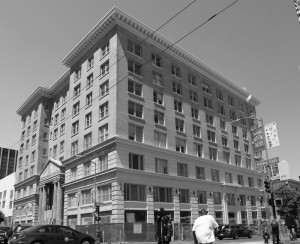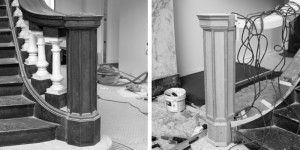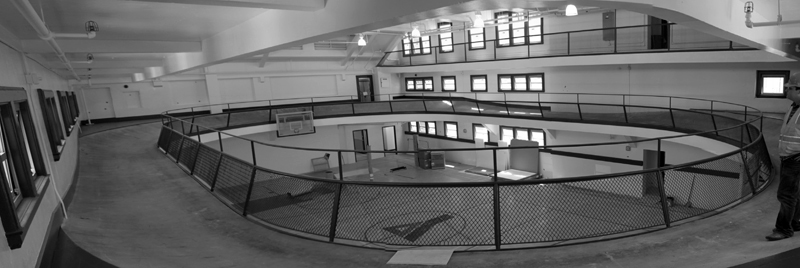
Heritage’s November Lecture, “Then and Now: Preservation in the Tenderloin,” will celebrate the transformation of the former Central YMCA into the Kelly Cullen Community. The Tenderloin Neighborhood Development Corporation (TNDC), a nonprofit organization whose mission is to provide safe, affordable housing with support services for low-income people in the Tenderloin, is converting the historic building at 220 Golden Gate Avenue into 174 units of permanent affordable housing for the chronically homeless. The building’s restored auditorium will provide a spectacular backdrop for the November 15 lecture.
 Designed by McDougall Brothers Architects in 1909, the monumental Italian Renaissance-style edifice is eligible for the National Register of Historic Places and is located within the National Register-listed Uptown Tenderloin Historic District. Heritage assigned the building a “B” rating in our 1978 Downtown Survey and it has since been listed as a Category I historic resource in Article 11 of the San Francisco formally listed in the National Register when construction is complete.
Designed by McDougall Brothers Architects in 1909, the monumental Italian Renaissance-style edifice is eligible for the National Register of Historic Places and is located within the National Register-listed Uptown Tenderloin Historic District. Heritage assigned the building a “B” rating in our 1978 Downtown Survey and it has since been listed as a Category I historic resource in Article 11 of the San Francisco formally listed in the National Register when construction is complete.
The building’s long tradition of civic and community uses will continue in its newest incarnation. During World War I, the Central YMCA hosted wartime fundraising campaigns and post exchanges. As the country descended into the Great Depression, those in need would pass through its doors to claim public welfare assistance. The building would later house the fledgling Golden Gate College, which would become Golden Gate University. The facility was little altered during its life as a YMCA; an auxiliary hotel was built in 1928 to accommodate overcrowding (this was sold by the Y to a separate owner in the early ‘90s), and the main lobby and entrance were remodeled in 1952.
 When the YMCA relocated to a new facility down the street at 357 Golden Gate Avenue, TNDC seized the opportunity to convert the building into apartments for the homeless. “They don’t make buildings like this anymore,” says Mara Blitzer, TNDC senior project manager. “It’s a tremendous beauty, and every time I experience it, it becomes a little richer. It has quite a community history, too, the people who were touched by it. It’s very special — elevating this kind of space with dignity and beauty to provide for the most needy.”
When the YMCA relocated to a new facility down the street at 357 Golden Gate Avenue, TNDC seized the opportunity to convert the building into apartments for the homeless. “They don’t make buildings like this anymore,” says Mara Blitzer, TNDC senior project manager. “It’s a tremendous beauty, and every time I experience it, it becomes a little richer. It has quite a community history, too, the people who were touched by it. It’s very special — elevating this kind of space with dignity and beauty to provide for the most needy.”
The vast majority of the building’s original features were retained and restored as part of the project, including Classical Revival embellishments found throughout the interior, a two-story lobby with glass atrium, the historic Boy’s Entrance, and the auditorium complete with mezzanine seating. The grand staircase rising from the lobby was reconstructed to match its original appearance. Such meticulousness has paid off in more ways than one. Because the work meets federal preservation standards, the project was categorically exempt from review under the California Environmental Quality Act and qualified for Federal Rehabilitation Tax Credits that contributed $17 million toward the $94 million construction cost.
As work nears completion, “the steady grind of complications required by the transformation of a YMCA into supportive housing within a complicated historic building is finally giving way to the excitement of bringing an old building back to life,” notes lead architect Chris Duncan of Gelfand Partners Architects. This reverence for the building is shared by the entire project team and is reflected in the high quality of craftsmanship seen throughout. The project’s preservation architect, Frederic Knapp, adds, “The exterior will continue to convey the building’s long and influential role in the community, and the restored historic interior spaces will mean future residents have a home that is much more than just ‘housing.’ ”
Heritage’s November lecture, “Then and Now: Preservation in the Tenderloin,” will take place at the Kelly Cullen Community on Thursday, November 15 at 6pm. Construction of the Kelly Cullen Community will still be in progress, so attendees will get a sneak peak at the restored auditorium. Join us in November to learn more about the project and other preservation efforts in the Tenderloin. (Photos by Sean Aung)
